The Economist released a list of top-ten fastest growing cities around the world. Three cities from Kerala have featured in the top-ten list – Malappuram, Kozhikode and Kollam. Two broad perspectives have emerged after this announcement. What are those perspectives & where do the numbers come from? Here is a deep dive.
In a recent post, the Economist released a list of top-ten fastest growing cities around the world according to a chart prepared by Economist Intelligence Unit (EIU). Three cities from Kerala have featured in the top-ten list – Malappuram (1st position), Kozhikode (4th position) and Kollam (10th position). The EIU survey also features Thrissur (13th position), Surat (27th position) and Tirupur (30th position). The total percentage change in the population of each city, based on a 2015-20 forecast, has been outlined in the chart released by EIU. In light of these intriguing numbers, two major perspectives have emerged. While some are lauding this as remarkable growth of smaller cities, others are attributing this growth to increase in the Muslim population in North Kerala.

In light of these perspectives, the purpose of this article is three-fold.
- First, to unpack the urban profile of these cities using the population data from Census 2001 and 2011 since the forecast in the list is based on Census data.
- Second, to understand the context within which these changes are emerging by tracking rural and urban population trends within these cities.
- Third, to critically look at claims that attribute the population growth of these cities in North Kerala to the rise in the Muslim population.
Where do these numbers come from?
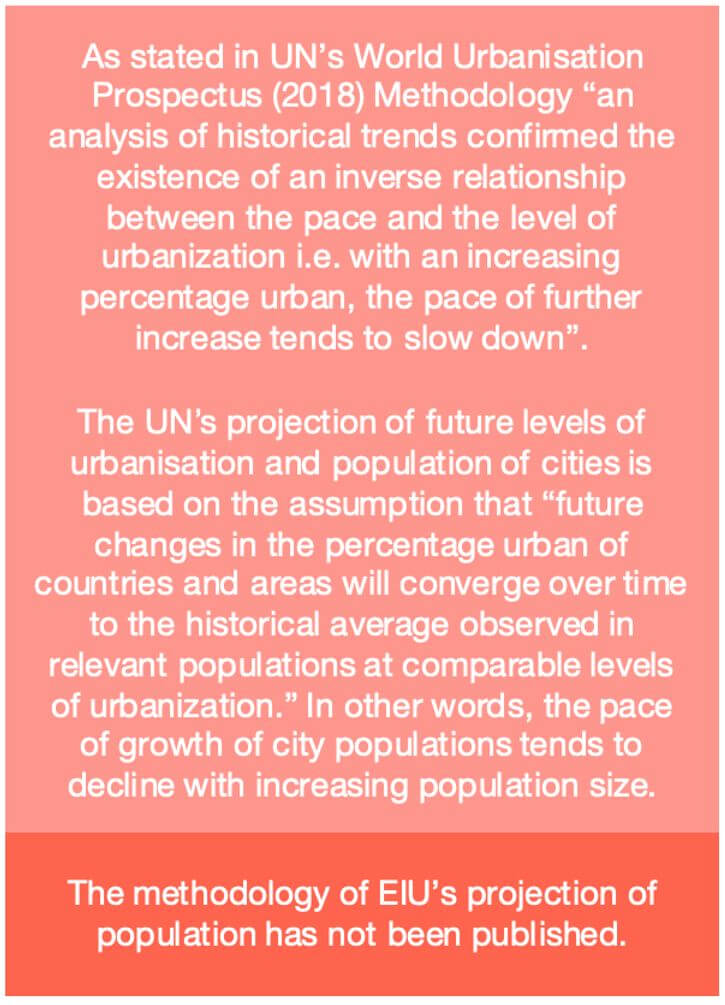
The findings of the EIU survey were juxtaposed with UN Population Division’s database and publications, as the EIU survey mentions UN Population Division as its source. The Population Division of the UN Secretariat’s Department of Economic and Social Affairs provides analysis of population trends based on all three components of population change – fertility, mortality and migration. In preparing estimates and projections of the urban population, the United Nations relies on data from national sources such as Census and other additional national datasets and reports.
In the World Urbanisation Prospectus 2018, of the UN Population Division, a list of fastest-growing urban agglomerations in 1990-2018 and 2018-2030 has been published, based on population size and average annual rate of change. Four cities from India have featured in the list – Malappuram (4th position), Kollam (18th position), Thrissur (23rd position) and Surat (25th position).
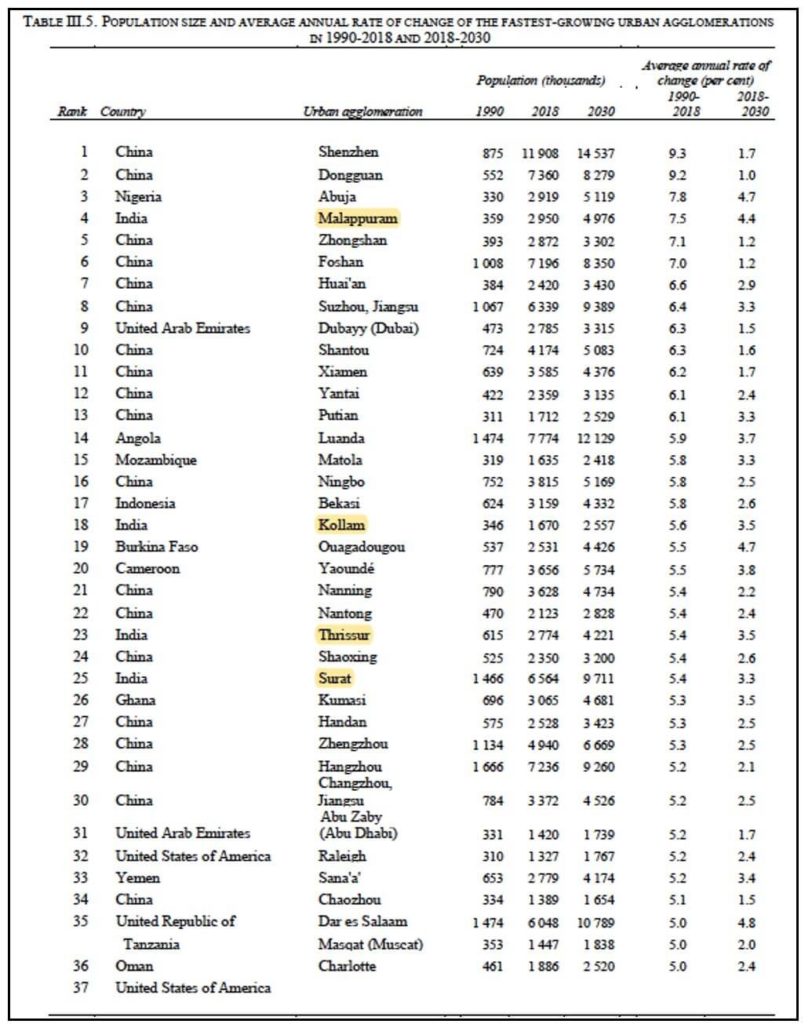
Before moving forward, let’s take a look at these frequently used terminologies:
- District: An administrative unit, as captured in Census & other national datasets, is divided into urban centres and rural components.
- Urban Agglomerations: UN defines urban agglomerations as “population contained within the contours of a contiguous territory inhabited at urban density levels without regard to administrative boundaries. It usually incorporates the population in a city or town plus that in the suburban areas lying outside of, but being adjacent to, the city boundaries.” Census defines a UA as “a continuous urban spread consisting of a town and its adjoining urban outgrowths or two or more physically contiguous towns together”.
- City: Census defines cities as “towns with population of 10,000 and above.” It is also a general term used for urban centers, not representative of their administrative boundaries.
The Geographical Expansion of Urban Agglomerations
In line with UN Population Division’s methodology, the Census 2001 and Census 2011 database is used to track changes in the population and demographic composition of these cities. It is important to note that in the state of Kerala, 13 Urban Agglomerations of 2001 Census continue in 2011 Census also, but with jurisdictional changes as a result of the addition of a number of census towns. These 13 Urban Agglomerations include Malappuram, Kozhikode, Kollam & Thrissur with high numbers of additions in the number of census towns for each of these Urban Agglomerations.
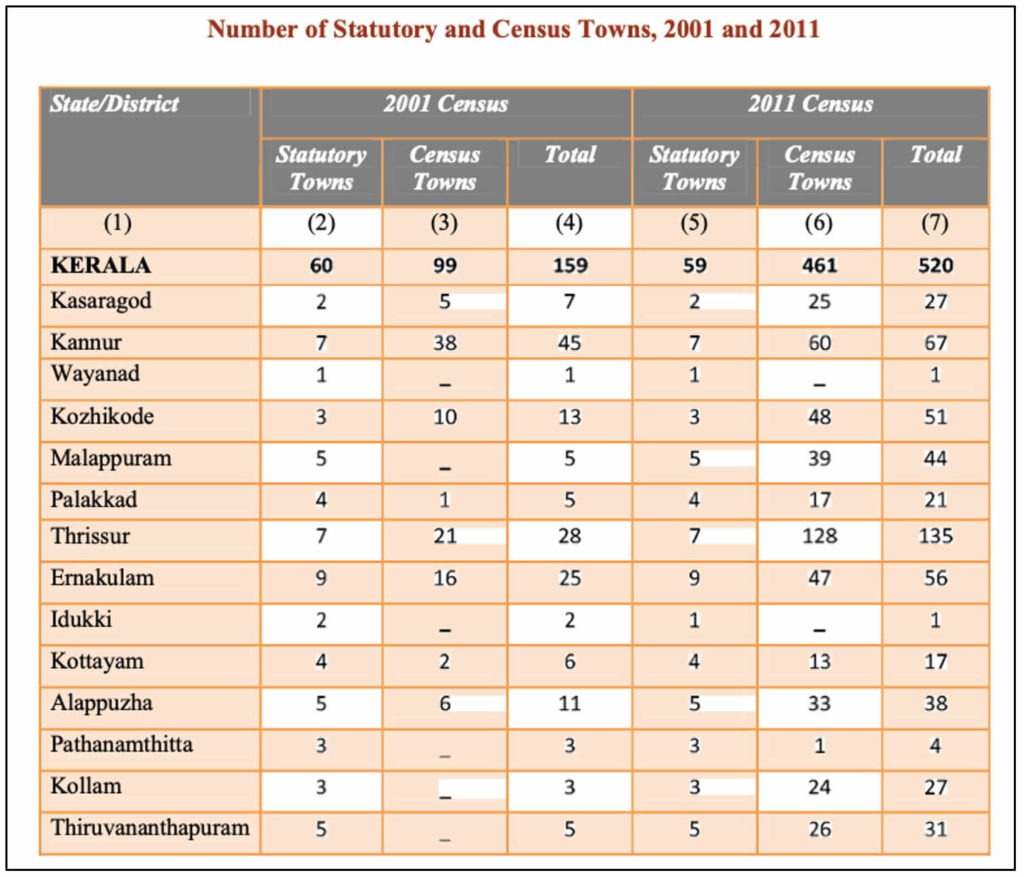
Therefore, it can be established that the geographical expansion of the above-mentioned urban agglomerations has an important role to play in the population growth recorded between 2001 and 2011 Census. This partly explains why the overall change in urban population as noted below, stands particularly high (highest for Malappuram, followed by others). To understand this growth further, each city’s profile has been explained and to understand if there has been any change in the demographic composition. Further, religion-wise population in urban and rural parts of these districts has been compared between Census 2001 and 2011. The primary focus is on two major religious communities – Hindu and Muslims – in order to critically analyse the claims of Muslim population growth in urban areas of North Kerala cities.
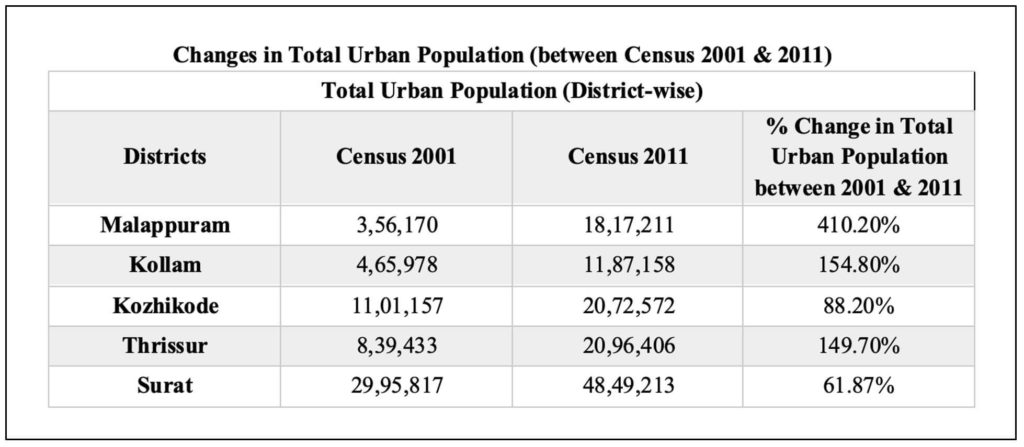
Urban Profiles of these cities
Malappuram
The profile of Malappuram reveals that while the change in the district’s urban population is high, the overall change in the district’s population (rural and urban combined) remains low. Both Hindu and Muslim populations have moved out of rural areas and their populations in urban areas have increased manifold (more so for Muslims as compared to Hindus). The demographic composition of urban Malappuram, in terms of religious composition, has not seen a significant change between 2001 and 2011, though there is a marginal increase in the share of Muslims.

Kollam
The profile of Kollam shows that the district’s population (rural and urban combined) has remained almost stable over the decade (between 2001 and 2011) with a growth of merely 1.94%. Although the change in the district’s urban population is significant, we can see that both Hindu and Muslim populations have moved out of rural areas and their populations in urban areas have increased manifold (more so for Muslims as compared to Hindus). The demographic composition of urban Kollam, in terms of religious composition, has not seen a significant change between 2001 and 2011. In fact, the share of both Hindus & Muslims has increased in Urban Kollam.
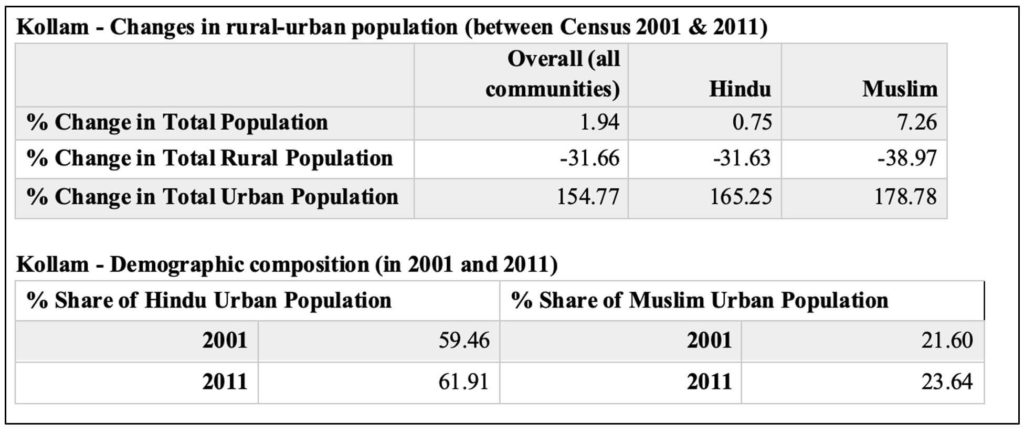
Kozhikode
The profile of Kozhikode reveals that while the change in the district’s urban population is relatively high, the overall change in the district’s population (rural and urban combined) remains low. Both Hindu and Muslim populations have moved out of rural areas and their populations in urban areas have increased manifold (more so for Hindus as compared to Muslims). The demographic composition of urban Kozhikode, in terms of religious composition, has not seen a significant change between 2001 and 2011, with a marginal increase in the share of Hindus.
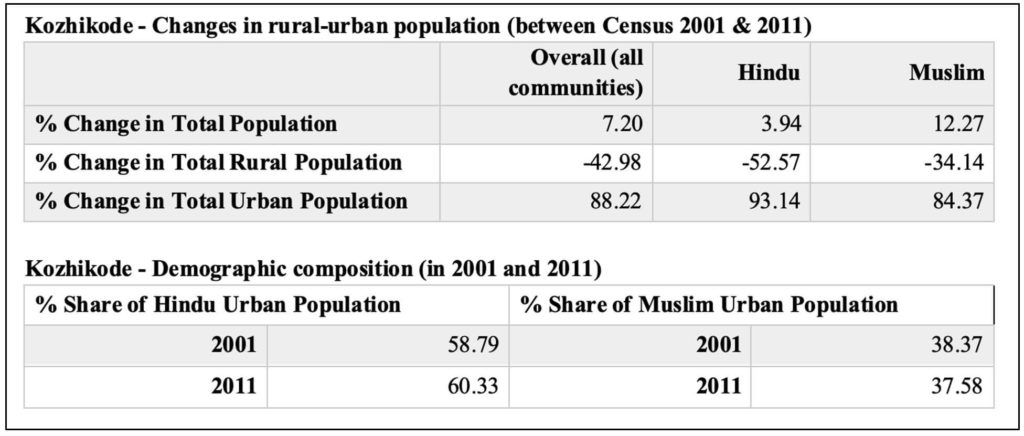
Thrissur
The profile of Thrissur shows that while the change in the district’s urban population is relatively high like in the case of other cities in Kerala, the overall change in the district’s population (rural and urban combined) remains low. Both Hindu and Muslim populations have moved out of rural areas and their populations in urban areas have increased manifold (more so for Muslims as compared to Hindus). The demographic composition of urban Thrissur has seen a shift in terms of an increased share of Muslim population (from 11.67% to 17.73%), while the share of Hindu population remained almost the same between 2001 and 2011.
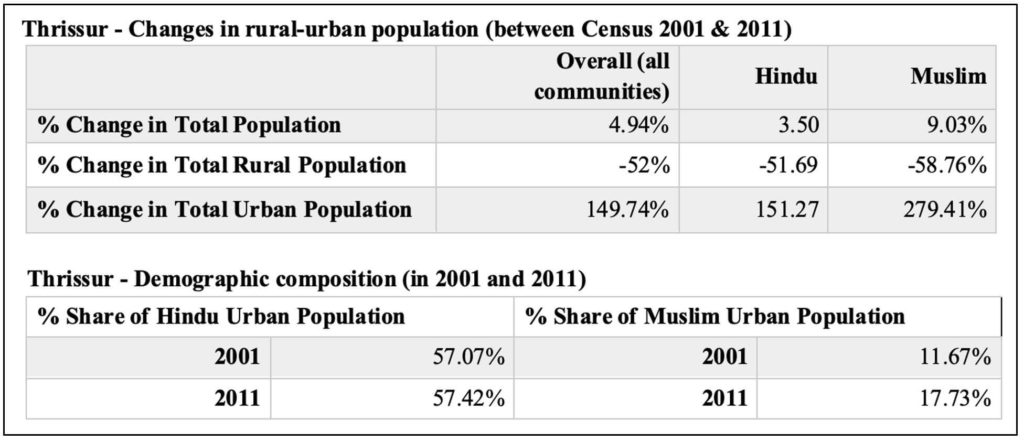
Surat
The profile of Surat shows that while the change in the district’s urban population is high, the overall change in the district’s population (rural and urban combined) is relatively low. In terms of decline in rural population, Hindus display a comparatively higher decline as compared to Muslims. There is no significant decline in Muslim populations in rural area, however, the population of both communities has increased in urban areas. The demographic composition of urban Surat, in terms of religious composition, has not seen a significant change between 2001 and 2011.
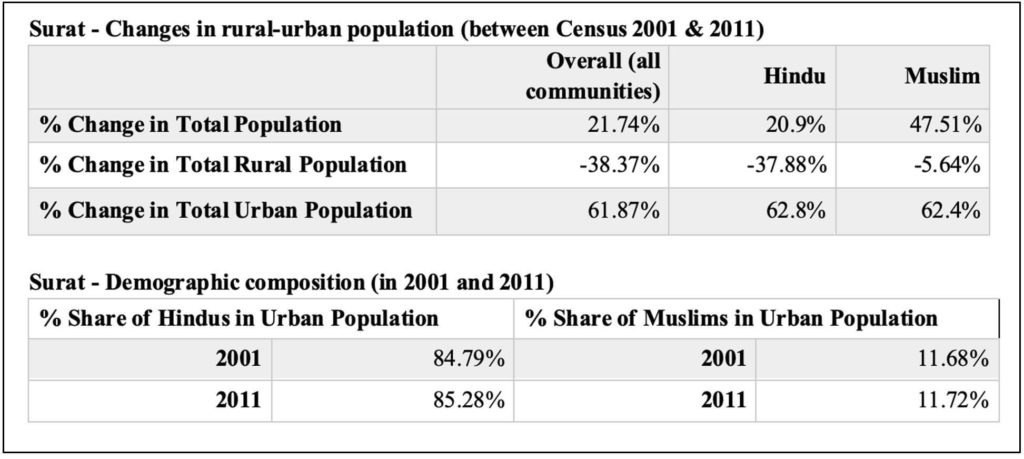
What does all this mean for the Bigger Picture of Urbanisation in these places?
First, the district profiles help us understand the rural-urban dynamics that has taken shape between Census 2001 and 2011. With rural areas facing a decline in population and urban areas witnessing a sharp rise, the overall population of districts has not registered an unprecedented growth.
Second, there has been no significant statistical change in the demographic composition of urban areas with respect to Hindu and Muslim populations – in most cases, except for Thrissur, where the share of Muslims increased by around 6%.
Third, in a nutshell, the growth in the urban population of Kerala’s featured cities in the EIU list between Census 2001 and 2011 is a result of geographical expansion and the urban migration from within the district and outside. It cannot be attributed to a growth in the Muslim population.



1 Comment
Enriching and well researched. Good interpretation as it gives a real perspective to understand the demographic change. It also tries to set course for real problem of leaving rural centers and increasing burden on urban centers. This article successfully eliminates interpretations used to create panic and divide which remain anyways irrelevant.